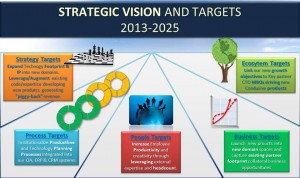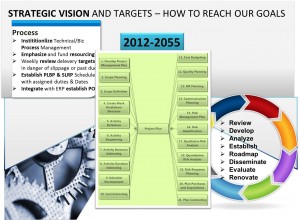If an enterprise needs to establish a strategic vision that maps out a clear path to an end state vision, then specific action items can be set around well defined targets in:
- Strategy Targets that help expand the footprint of a technology or products
- Process Targets the sheppard teams to accomplish goals and deciplined cycles of activity
- People Targets that help increase productivity and creativity
- Business Targets that set fiscal milestones and performance meterics
- Ecosystem Targets that help stimulate the health and growth of ecosystem partners and fellow travelers.
Below is an example of process targets that help:
Strategic Technology Planning Process
- Review existing technical plans and strategic direction
- Develop a Technology Mission Statement
- Analyze Current raw Data
- Establish Goals and Objectives
- Develop and Implement Project Plans and Timelines (Roadmaps)
- Disseminate, Monitor, Evaluate, Renovate the Technology Plan.



